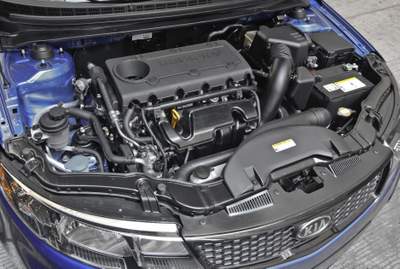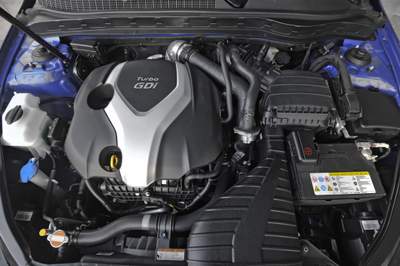 This article looks at a 2004 Kia Sorrento that the owner says is losing power and stalling with no established pattern. It will run well for days or even weeks at a time without a problem, only to then act up without warning, but it always restarts. Needless to say, the customer was concerned whenever the vehicle was in use, fearing it was going to leave her stuck on the side of the road, or put her in a dangerous situation. Of course, if it were to break down and not start, our job would certainly be easier as the vehicle would be easier to diagnose. But, as you would expect, that thought did little to make the customer feel better about the situation.
This article looks at a 2004 Kia Sorrento that the owner says is losing power and stalling with no established pattern. It will run well for days or even weeks at a time without a problem, only to then act up without warning, but it always restarts. Needless to say, the customer was concerned whenever the vehicle was in use, fearing it was going to leave her stuck on the side of the road, or put her in a dangerous situation. Of course, if it were to break down and not start, our job would certainly be easier as the vehicle would be easier to diagnose. But, as you would expect, that thought did little to make the customer feel better about the situation.
Our initial inspection had us looking for codes with an enhanced scanner in the hope we’d find a code that may give us a hint on where to start with this one. We found no codes, but we just didn’t take off the scanner and go back to scratching our heads. One of the things I’m always telling my techs is to use the information that the scanner offers when diagnosing a driveability issue. Even if there are no codes present, the data list will give you a good real-time look at what’s happening with the computer-controlled systems.
At this point, we didn’t know if we were having a problem with fuel delivery or if the ignition was shutting down. Our experience tells us that if it were the ignition, we would expect to see a code set, whereas the fuel pressure isn’t monitored. Talking to the young tech who was going to road-test the vehicle, we first had to decide which scanner parameters we wanted to be displayed. By choosing the PIDs we were interested in, rather than choosing “all,” the scanner will report and record data we’re interested in at a faster rate and, hopefully, show us a trend that will help with our diagnostic process.
 LONG- AND SHORT-TERM FUEL TRIMS
LONG- AND SHORT-TERM FUEL TRIMS
We decided to concentrate on the PIDs related to the fuel system. By looking at the long- and short-term fuel trims, we would see if the pump was able to deliver the fuel needed to keep the trims in the expected near-zero range. While we didn’t get any fuel trim codes in memory, by the way the vehicle was failing we had hoped to see it going lean at times that would have the ECU adding fuel to the system, resulting in positive fuel trim numbers.
We also brought up calculated load as well as engine rpm with the thought that if the rpm dropped out, we would rethink the idea that it wasn’t an ignition fault. Calculated load is one of my “go to” parameters as it’s a good way to see how the ECU is responding to driver inputs. By monitoring the load, we get an overall picture of ECU inputs.
Working with the young tech, I took this as an opportunity to see how well he understood what he was looking at and what the numbers meant. As we spoke, it was clear he had a pretty good idea and he seemed to understand that it was important to first look at the long-term trim for these reasons: to get an idea of what the fuel adjustment was doing, and realize the long-term number will set the platform from which the short-term will work. He understood that while we might see a short-term number near zero, it was important to know where the long term was since that is the baseline the short term was working from. Before the road test, we made sure that the computer was reset and all the trims were at zero.
With this Sorrento, we suspected a fuel pump problem but, as is usually the case with these intermittent problems, we couldn’t get it to act up while we had it. We knew the customer well and also knew she wasn’t in the position to make an investment on our best guess and not being able to offer some guarantee that the pump would take care of the problem. The customer did agree to leave the car for a few days so we could try to confirm the diagnosis. In addition to getting the scan tool ready for the road test, we also hooked up a low-amp probe on the fuel pump wire at the pump.
On this vehicle, we had an access plate that made it easy to get to the top mounting plate for the in-tank pump. This not only allowed us to hook up the probe, but we were also able to check the condition of the wiring and the integrity of the connections. Being in the rust belt, we have seen more than one vehicle where the environment has taken its toll on the fuel pump mounting plate connections. In our case, the plate and wiring were in good condition. With easy access to the wiring, as mentioned earlier, we did connect the low-amp probe to monitor the pump operation hoping we could get it to act up.
 ZEROING IN
ZEROING IN
Whenever we are faced with this kind of an intermittent problem, our first step is to look at the wiring diagram for areas that could point to a problem, or to see how things are tied together that may aid the diagnostic process. Looking at the diagram, it showed this Sorrento is equipped with a fuel cutoff safety switch mounted on the right-front panel area under the hood. Since the vehicle was running, this obviously wasn’t the problem, but it would be a good place to hook up the low-amp probe to see the current draw on the pump. On the other hand, if we were faced with a no-start, no-fuel pump issue, it would be the first place to look.
If you’re not using a low-amp probe and current ramping as a diagnostic tool in your shop, it should be considered. Probes are available at a reasonable cost and you may already have the graphing capabilities you need to take advantage of this testing. Spend some time searching “current ramping” on www.import-car.com where Gary Goms and others have done a good job of explaining the procedures. There is a learning curve, but it’s certainly worth the effort.
Back to our Sorrento that’s cutting out and hooked up to the scanner and current ramping setup. Everything looked good: fuel pump amp draw and rpm was as expected at 5 amps and over 5,000. Both the long and short fuel trims were near zero. On the road, the car ran well, as those with intermittent problems usually do. The calculated load up a hill at wide-open throttle was in high 90s and the fuel trims stayed close to zero.
On the third drive, we finally got a hint of the problem when we experienced a hesitation at highway speed. We noticed a small drop in calculated load, but more interesting was that the amp draw dropped on the pump and pump rpm momentarily increased. This indicated that the pump wasn’t working as hard, but knowing there was fuel in the tank, we removed the pump and found clumps of leaves floating in the tank with some also wrapped around the filter and blocking the flow of fuel into the pump.
On this vehicle, the gas door didn’t lock and, when questioning the customer, it turns out she was having some dispute with kids in her condo complex. So, we figured that was how the leaves got in the tank. Needless to say, a locking cap was installed before the car was returned.
IGNITION FAILURE SENSOR DTC
Unlike the problem described above, Kias have some issues that are unique to the brand. A code you may not be familiar with is a P0320, Ignition Failure Sensor Circuit Malfunction. The ignition failure sensor is responsible for keeping track of the voltage drop on the positive side of the coils so the ECU can monitor the coil function. In order to perform this function, the fused power to the coils has to pass through this device; the code is set when the ECU doesn’t see an ignition signal.
This device is also used as a tachometer amplifier. There have been reports of these sensors failing and causing a no spark, no battery power at the coil condition and/or erratic tachometer operation. Keep in mind that this circuit is fused so don’t overlook the basics. If there is no voltage going into the sensor, there can’t be any output to the coils. The sensor can be jumped, if necessary, to confirm your diagnosis. The pink wire is the current feed from the fuse, while the black-and-white wire feeds the battery voltage to the coils.
Kias are also not immune to the relatively common cam and crank sensor codes. Usually presented as a stalling condition, they often will start right back up and can be driven in. In this case, if there’s a sensor code present we just change the sensor. On the crank sensors, it’s not uncommon for the harness to be damaged by the timing belt if the harness is not routed properly. There are also numerous reports of the cam sensor being damaged during water pump replacement.
Courtesy ImportCar.














